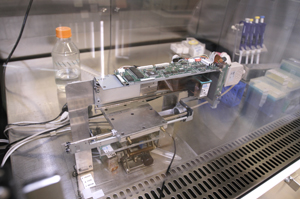By Joe Velarde

Technology involving printable biomaterial such as skin cells seems like something out of a science fiction novel or a film. However, Thomas Boland, Ph.D., professor of metallurgical and materials engineering, has been involved in this breakthrough in biomaterials research at The University of Texas at El Paso.
The implication of this research is invaluable, said Laura Bosworth-Bucher. She, along with her company Tevido Biodevices, is looking into advancing Boland’s technique to make it commercially available.
“Chronic non-healing wounds are becoming more frequent,” Bosworth-Bucher said. “Foot ulcers affect approximately 10 to 15 percent of patients with diabetes throughout their lifetimes, and by 2025, it is estimated that 300 million people will have diabetes.”
Ultimately, the goal of Boland’s research is to create a wound care material that integrates with the host tissue – skin – which is considered the largest organ of the human body.
“We have been investigating a biodegradable hydrogel which is derived from natural proteins and carbohydrates, creating a scaffold to use as a substrate to grow cells,” Boland said.
According to the research abstract, this hydrogel is a unique composite of gelatin and alginate, both materials with very high biocompatibility, promoting cells growth and vascularization.
The actual machine used to create this material is a basic HP Deskjet 340 printer that uses HP 33 cartridges modified to control temperature and deposition. An aluminum plate was adapted to the printer using the paper feeding sensor and two switches along the y-axis of the machine to evenly distribute the gelatin into the form.
“The use of precision printers allows us to build vascularized channels into the scaffolds, which we hypothesize will improve the integration of the engineered skin with existing tissue,” Boland said.
Boland said he hopes his research will provide better outcomes for patients with peripheral neuropathy and vascular disease.
“(These) conditions reduce the normal pain sensations and healing of minor traumas, allowing the development of chronic non-healing ulcers, often preceding lower-extremity amputation (when the ulcer becomes infected and gangrenous),” Boland said.
